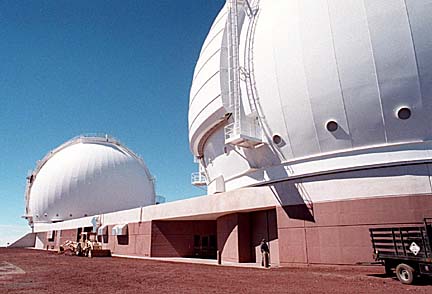


|
Two teams of astronomers, working independently with the world's largest telescopes, say they have found the strongest evidence yet of a solar system around a star visible with the naked eye from Earth. Astronomers say clues
point to new solar systemTwin Big Island telescopes spot the
evidence that exists around a nearby starBy David Briscoe
Associated PressTheir findings have not yet been published in a scientific journal, but were reported yesterday by the W.M. Keck Observatory on the Big Island and at an astronomy symposium in Arizona.
The twin Keck telescopes atop 13,796-foot Mauna Kea have found dozens of planets and spotted the universe's most distant object, 15.5 billion light years from Earth.
The latest discovery is relatively close -- around the star Beta Pictoris, just 63 light-years away.
Infrared images from the Keck telescopes reveal an important clue in the configuration of dust in the "debris disks" around Beta Pictoris, indicating the existence of more than one planet, scientists said.
The evidence of planets can be seen only with the Keck telescope's highly sophisticated equipment, but the star itself is visible from Earth without a telescope as a fuzzy, dim light.
The distorted disk plane occurs in the Keck images at distances at which a planet might be expected from the star, said professor David Koerner of the University of Pennsylvania, who led a team working from the Keck II telescope.
"No obvious explanation exists for its origin other than the gravitational influence of planets," Koerner said. "The different inclinations of dust grain orbits around Beta Pic bear a resemblance to those of planetary orbits in our own solar system."
Citing the configuration of Earth, Pluto and Mercury, he said the Keck images "may be interpreted as circumstantial evidence for a similarly organized planetary system."
Koerner's team and another group of astronomers who worked at Keck I were presenting their findings yesterday at the Gillett Symposium on the formation of planets in Tucson, Ariz.
At Keck I, Alycia Weinberger of the Carnegie Institution of Washington and her colleagues used a wavelength spectrometer attached to the telescope to examine both the composition and geometry of the dusty region.
The scientists also found that particles in the area of the warp are hotter than expected.
"It may be that as a planet warps the disk, it also causes more collisions of rocks in its neighborhood," Weinberger said as an explanation of the higher temperatures.
As further evidence, the warp detected by the telescope was found to be offset in the opposite direction from that of a larger-scale warp detected previously by the Hubble Space Telescope, she said.
"This double warp is believed to be due to the presence of one or more unseen planets and constitutes one of the strongest pieces of evidence yet which links observations of circumstellar disks to the actual formation of planets," the Keck release said.
W.M. Keck Observatory